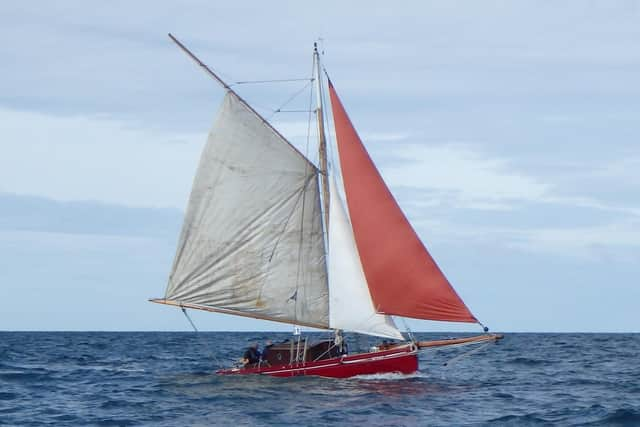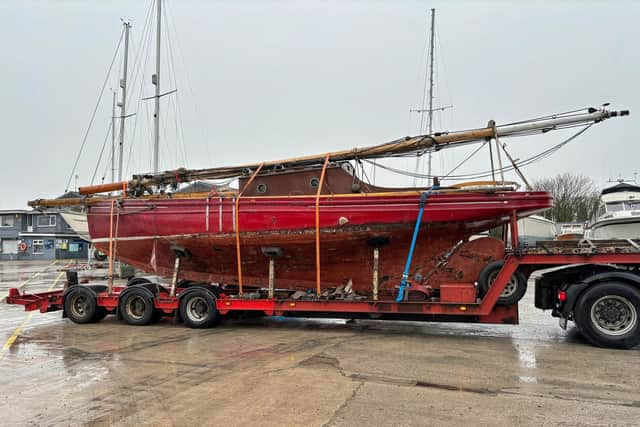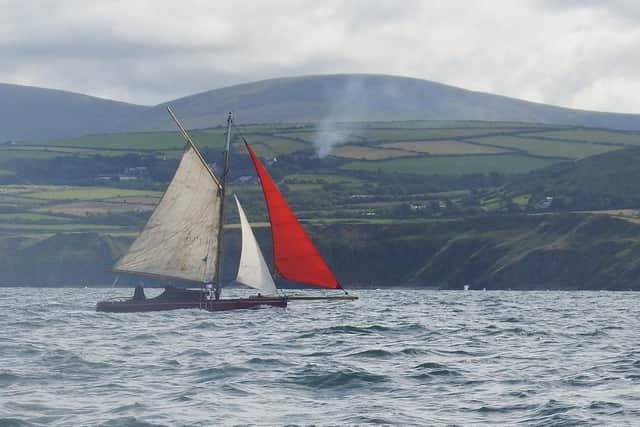Remarkable 'Prawner' boat returns to set sail once again on her home waters of Morecambe Bay
and live on Freeview channel 276
Spray is currently at Glasson Dock, where her new owners, the Morecambe Bay Prawners Trust, are undertaking routine maintenance prior to setting her to sail around the bay and beyond this summer.
The ‘Prawner’ was the local fishing boat of the Lancashire and Westmorland coast, whose lines evolved during the 19th and early 20th centuries to fish the frequently hazardous waters of Morecambe Bay.
Advertisement
Hide AdAdvertisement
Hide AdIn 1900, Morecambe and Fleetwood had a fleet of around 100 boats to service the booming appetite of seaside holidaymakers for potted shrimps.


To secure this valuable catch, a ‘Prawner’ had to be able to cope with the short sharp waves, powerful tides, lurking sandbanks and channels of the eastern Irish Sea and settle – or ‘take the ground’ – when the tide ebbed to reveal the miles and miles of sands.
In addition, they needed to carry sufficient sail to trawl a heavy net and be fast enough to get their catch ashore and so secure the best prices.
Trustee Robin Ashcroft said: “Spray is a fully seaworthy example of what is a truly remarkable type of boat. A ‘Prawner’ is fast, seaworthy craft which could survive the frequently treacherous seas of Morecambe Bay to secure a good living for her skipper and crew.
Advertisement
Hide AdAdvertisement
Hide Ad"They are very much a part of the heritage of the bay and the Irish Sea, and it’s important we keep them sailing on their home waters for both locals and visitors to experience. We are particularly keen to help young people experience living history.”


History of Spray
Spray was built in 1896 and fished under various owners along the north Lancashire and Cumbrian coast – from Morecambe across to Barrow and then up to Silloth and Annan. One of these owners was James Baxter, whose family firm still works Morecambe Bay and produces Potted Shrimps out of their Flookburgh base, which are now distributed throughout the country and abroad.
It was an intensely competitive trade, which produced an increasingly efficient and speedy boat to give a skipper an edge over rival fishermen. The design evolved not on a drawing board, but through a ‘Half Model’ – a miniature wooden version of the planned boat, through which boatbuilder and owner could work together and use their practical experience to refine the boat’s lines to secure an advantage over their rivals.


In 1978, after her working life was over, Spray was given a cabin and converted into a cruising yacht sailing out of the Mersey and then Maryport. Her Gaff Rig set her apart from modern glass fibre, Bermuda Rig yachts, but her excellent sea keeping qualities meant that she could more than hold her own when the wind whipped up and the Irish Sea’s notoriously steep waves kicked in.
Advertisement
Hide AdAdvertisement
Hide AdShe was then bought by the Morecambe Bay Prawners Trust earlier this year with the objective of maintaining interest in the bay’s fascinating maritime heritage and seamanship while allowing as many people – particularly young people – as possible to experience these remarkable boats.
The heart of ‘Prawner’ design and building was at Arnside, at the legendary Crossfield Boatyard – which can still be seen along the town’s promenade – with the trade spreading as far afield as Conwy in the south to the Solway to the north, as the fishermen trawled their nets further afield to secure their catch of shrimp for the burgeoning seaside tourist trade.
What the future holds


Once afloat, Spray will be moored at Sunderland Point to be regularly sailed around Morecambe Bay and further afield on the waters off the Lancashire and Cumbrian coasts.